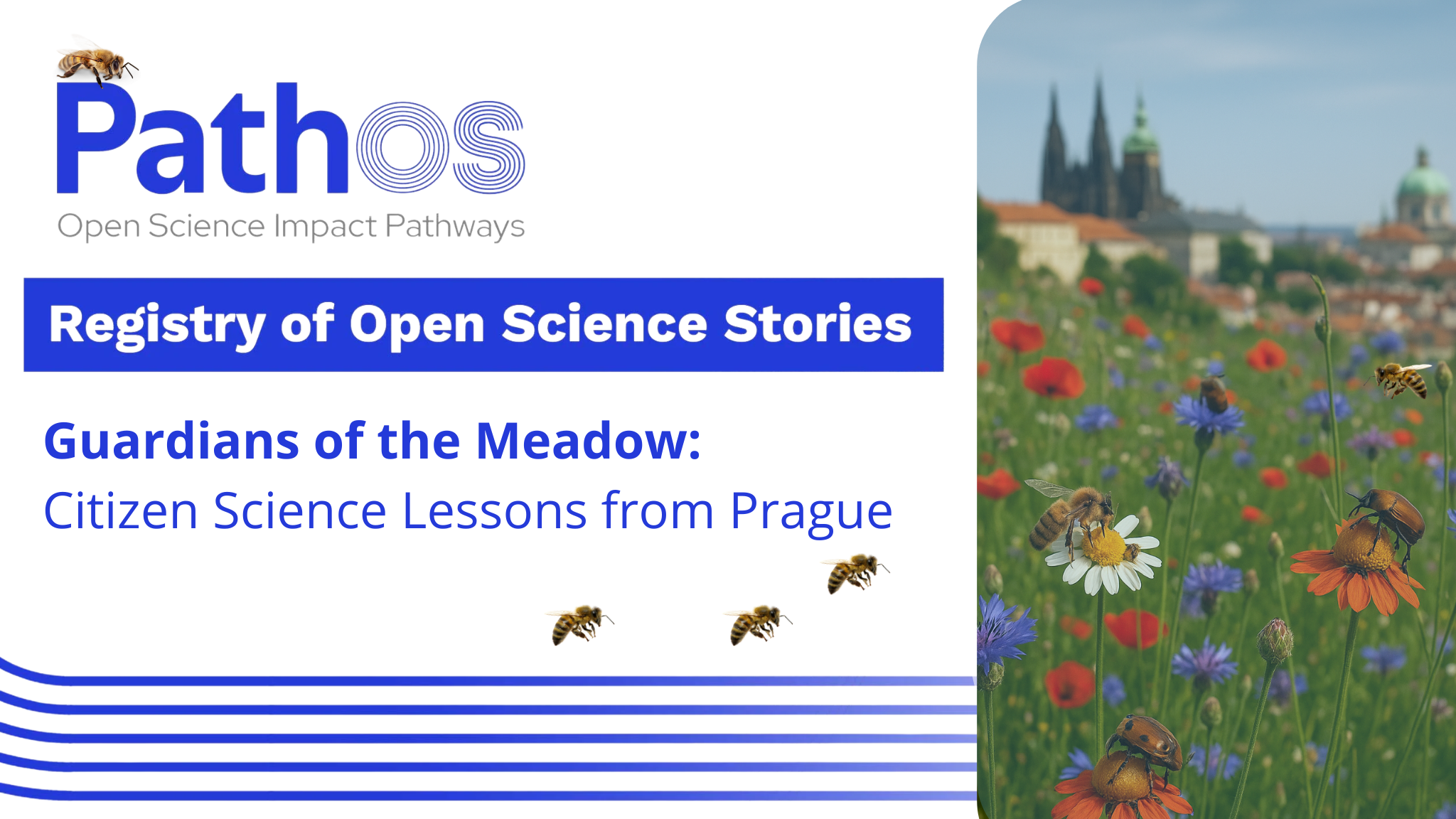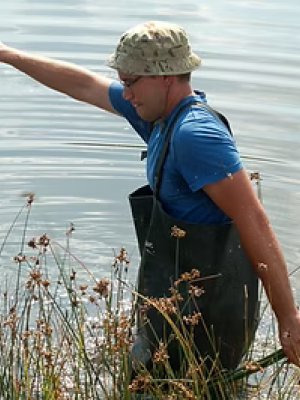Guardians of the Meadow:
Citizen Science Lessons from Prague
Citizen Science Lessons from Prague

Within PathOS we are collecting stories on how Open Science (Open Access to publications, Open/FAIR data and software, collaborations with citizens) has made a positive or negative impact. Our ultimate aim is to highlight stories of Open Science practices and how these are linked to impactful outcomes. In this way, we hope to foster a learning experience and to inspire others to follow. Join us and read the first Open Science stories!
Could you briefly introduce yourself and what your Open Science story is about, including its time (e.g. year range) and location?
My name is Filip Harabiš, and I’m a freshwater ecologist and my favorite group are dragonflies. About seven to eight years ago, I found myself frustrated with the limitations of nature conservation in aquatic ecosystems in the Czech Republic. There are powerful stakeholders, like fishpond owners, who are often unreceptive to scientific input. It felt like running into a wall.
At the same time, global concern was growing around the decline of pollinators. Unlike freshwater ecosystems, this was a space where we saw a realistic opportunity to make a visible impact - even without institutional power behind us. So we launched the initiative “Praha kvete” (Prague Blooms), focused on educating and activating children and the general public around biodiversity loss in urban environments, especially regarding pollinators.

"Traditional publishing reaches only a small academic audience, whereas engagement with schools, media, and public institutions can translate knowledge into real-world change"
What was the context or background in which this Open Science practice was used? What were the goals or expected outcomes?
Initially, our main goal was to raise awareness and shift public opinion. We realised that while many people sense that “something is happening” in nature, they don’t have a tangible reference point. For example, older generations still remember having to clean their car windshields full of insects after a summer drive, something that rarely happens today. That decline is real and measurable.
We began by offering guides on how to plant small wildflower meadows in urban areas and even tried establishing them ourselves. But we quickly learned that maintaining these spaces without local commitment was unsustainable. So we shifted our focus to education - working with groups that showed genuine interest. Over time, we started collaborating with a wide variety of actors: schools, community centres, the National Agriculture Museum in Prague, and even institutions like hospitals and banks, which control green spaces and can implement biodiversity-supportive measures.
What was your role or relationship to this Open Science practice? Were you a direct participant, an observer, or something else?
I initiated and coordinate the project, and my role has evolved over time. While I started as a scientist looking for more effective conservation pathways, I found myself increasingly involved in public communication, science education, and now also technological development. I actively work with schools, local institutions, and partners to co-create content and monitor progress, and I’m also leading efforts to develop new digital tools to support our scientific goals.
How was this Open Science practice implemented, to your knowledge? Who were the key actors involved?
We’ve collaborated closely with the Prague City Hall, Environmental Protection Department, which has provided both support and funding. Their engagement gave us access to grants and credibility within the municipal ecosystem. A key partner from the beginning has also been the National Agriculture Museum in Prague, which offers space and visibility for our outreach events.
Over the years, we’ve built a network of schools, museums, and community institutions willing to experiment with biodiversity-friendly urban management. Most recently, we’ve begun working with utility companies like Pražské vodovody a kanalizace (the Prague water utility), which manage large and often underused green areas, such as water reservoirs, where we can install experimental biodiversity support measures.
Were there any quantifiable outcomes or measurable successes linked to this practice? What metrics or indicators were used to evaluate these outcomes, if any?
Unfortunately, we have struggled to gather consistent, quantifiable data through traditional citizen science approaches. We originally hoped schools and other partners would help us track pollinator visits or biodiversity changes, but follow-through proved difficult. Educators often see our programme as a one-time activity rather than an ongoing commitment.
This challenge led us to explore alternative methods. We are now developing an automated insect counter using image recognition powered by AI. This tool (currently in prototyping) will be used as both an educational tool (in school robotics lessons) and a genuine data-collection device. If successful, it will allow us to generate real-time biodiversity data from various urban locations across Prague without relying on constant human observation.
What impacts, both expected and unexpected, did this practice have? Were there any surprising developments or results?
The most surprising development has been our growing engagement with large corporations. Initially, we envisioned a grassroots, community-oriented project. But our public visibility and credibility have led to unexpected collaborations—sometimes even with multinational companies like Mondelez.
In some cases, we’ve had to intervene to prevent well-meaning but ecologically harmful initiatives - like distributing invasive flower seeds purchased from hobby markets. In other cases, we’ve helped develop innovative biodiversity-friendly strategies in solar parks, transforming improperly maintained areas into habitats for pollinators. These partnerships were never part of our original vision, but they’re now a powerful extension of our impact.
What challenges were associated with this practice, from your perspective? What lessons can be drawn from its implementation?
The biggest challenge is maintaining engagement over time. Czech society tends to prefer short-term, one-off events over long-term involvement. While we attract interest with educational sessions or public installations, transforming that into lasting commitment has proven difficult.
Another lesson is that to be truly “open,” a project must not only share information but also constantly communicate - often using the same media tactics as commercial entities. Competing for public attention means being as engaging and visible as entertainment content, which can be exhausting and requires skills outside traditional academic training.
How do you perceive this practice's influence on the wider scientific community or society? Has it affected your own views or approaches to research?
Absolutely. This experience confirmed for me that scientific knowledge without application has limited value. Traditional publishing reaches only a small academic audience, whereas engagement with schools, media, and public institutions can translate knowledge into real-world change.
It also changed my own trajectory. I now place much greater emphasis on the practical applicability of my research and actively look for ways to turn scientific findings into policy or urban design recommendations.
Based on your experience or observation, would you recommend this Open Science practice to others? Why or why not?
Yes, without hesitation. Especially for anyone in applied sciences or working at the intersection of science and society, openness is essential - not just in data sharing, but in tools, processes, and communication.
Thanks to open hardware and shared coding resources, we’re now building our own biodiversity sensors for a fraction of the price of commercial solutions. Communities across Europe are generously sharing blueprints and software, making complex research infrastructure accessible even to non-programmers.
That said, Open Science is not without risks. Some actors benefit from our openness without reciprocating, which can create power imbalances. But overall, the value of collaboration, creativity, and knowledge sharing far outweighs these drawbacks. The potential for accelerated progress and real impact is enormous.